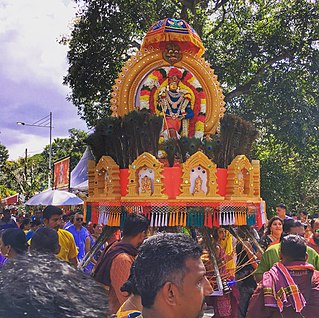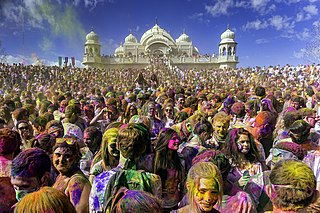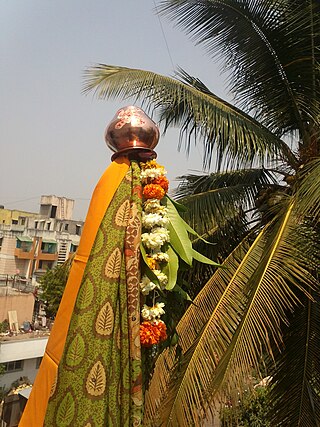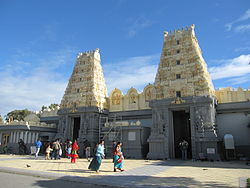The following outline is provided as an overview of and topical guide to Hinduism:

Thaipusam or Thaipoosam is a Tamil Hindu festival celebrated on the first full moon day of the Tamil month of Thai coinciding with Pusam star. The festival is celebrated to commemorate the victory of Hindu god Murugan over the demon Surapadman using a vel, a divine spear granted by his mother, Parvati.

Hinduism has been found in the Middle East since the early 16th century. Millions of members of the Indian diaspora, of different religions, reside and work in Arab states of the Persian Gulf; many of them are Hindu. Many came due to the migration of Indians and Nepalese expatriates and employees to the area around the Persian Gulf.

Hinduism is the fourth-largest religion in the United States, comprising 1% of the population, the same as Buddhism and Islam. The majority of American Hindus are immigrants, mainly from India, Nepal, Sri Lanka, and Bangladesh, with a minority from Bhutan, Pakistan, Afghanistan and other countries.

Hinduism is one of Sri Lanka's oldest religions, with temples dating back over 2,000 years. As of 2011, Hindus made up 12.6% of the Sri Lankan population. They are almost exclusively Tamils, except for small immigrant communities from India and Pakistan.

The Tamil diaspora refers to descendants of the Tamil speaking immigrants who emigrated from their native lands in the southern Indian subcontinent to other parts of the world. They are found primarily in Malaysia, Arab states of the Persian Gulf, South Africa, North America, Western Europe, and Singapore. It can be divided into two main diasporic clusters, due to geographical, historical and cultural reasons, as Indian Tamil diaspora and Sri Lankan Tamil diaspora.

Hinduism is a minority religion in Japan mainly followed by the Indian, Sri Lankan and Nepali expatriate residents of Japan, who number about 166,550 people as of 2022. It's also widely integrated into the native Shinto-Buddhist religion which has had a significant impact of Japanese culture; Buddhism is largely derived from Hinduism, and most of its cultural practices are similar to those found in Buddhism.
Anti-Hindu sentiment, sometimes also referred to as Hinduphobia, is a negative perception, sentiment or actions against the practitioners or religion of Hinduism. It exists in many contexts in many countries, often due to historical conflict. There is also scholarly debate on what constitutes Hinduphobia in the Western World.

Hinduism is the third-largest religion in Canada, which is followed by approximately 2.3% of the nation's total population. As of 2021, there are over 828,000 Canadians of the Hindu faith.

Hinduism is the second-largest religion in Fiji, and primarily has a following among Indo-Fijians, the descendants of indentured workers brought to Fiji by the British as cheap labour for colonial sugarcane plantations. Hindus started arriving in Fiji starting in 1879 and continuing through 1920, when Britain abolished the slavery-like indenture system. Fiji identifies people as "Indo-Fijians" if they can trace their ancestry to the Indian subcontinent, Hindus form about 27.9% the population of Fiji.

Hinduism is a minority faith in Kenya, constituting 0.13% of the population of Kenya. Due to the efforts of the Hindu Council of Kenya, Kenya is one of only three African countries to recognise Hinduism as a religion. Hindus are free to practise their religion in Kenya, and several Kenyan cities have Hindu temples. The Hindu temples in Kenya are mostly of north and west Indian architectural style.

Hinduism is the second largest religion in New Zealand. It is also one of the fastest-growing religions in New Zealand. According to the 2018 census, Hindus form 2.65% of the population of New Zealand. There are about 123,534 Hindus in New Zealand.

Hinduism is a minority religion practised by 0.3% of the population of Botswana. The practice of Hinduism in Botswana is concentrated in and around Gaborone and Selebi-Phikwe. The community of Hindus began to form in the early 20th century with the beginning of immigration from India to Botswana. Most Hindus in Botswana are of Indian descent.

Hinduism is a minority religion in Sweden practised by 0.13% of the population or 13,000 people out of a population of 10.5 million. Hinduism is practised mainly by persons of Indian origin and non-resident Indians together. A majority of them are Tamils, Punjabis, Bengalis, Gujaratis, Telugu's and Kannadigas.

Hinduism in England is the third largest religion in the country, with over 1,020,533 followers as of the 2021 Census. This represents over 1.5% of the English population, up from 1.1% the previous decade. Hindus are predominantly in the cities of London and Leicester, where they make up greater proportions of the population. England has a number of Hindu temples, including the Hindu temple at Neasden which is a large Hindu temple in Europe. In 2007, the largest Hindu Mandir in the North of England, the Bradford Lakshmi Narayan Hindu Temple opened in Bradford, West Yorkshire.

Hinduism is a minority religion in Wales constituting 0.4% of its population. Under half of Welsh Hindus settled there in the second half of the 20th century.

Hindus form 79.83% of the state's total population as per 2011 census. Hindus form the majority in all the districts of the state.The religion plays an important role in the lives of the Maharashtrian people in their day-to-day life. Vitthoba, along with other incarnations of Vishnu such as Rama and Krishna, Hanuman, Dattatreya, and Shaiva deities such as Shiva, Parvati, and Ganesha, are popular with Hindus of Maharashtra. The Varkari tradition holds a strong grip on the local Hindus of Maharashtra. The public Ganesha festival started by Bal Gangadhar Tilak in the late 19th century is very popular. Marathi Hindus also revere Bhakti saints associated with varkari sects such as Dnyaneshwar, Savata Mali, Tukaram, Namdev, Janabai, and Chokhamela. Many religious figures from 19th and 20th century are revered. They include Swami Samarth, Gajanan Maharaj, Sai baba of Shirdi, Tukdoji Maharaj, Gondavalekar Maharaj, and Gadge Maharaj.























